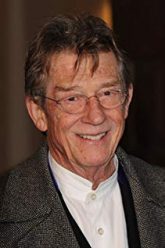Overview
| Born | in Chesterfield, Derbyshire, England, UK |
| Died | in East Runton, Cromer, Norfolk, England, UK (pancreatic cancer) |
| Birth Name | John Vincent Hurt |
| Height | 5′ 9″ (1,75 m) |
Mini Bio
This transatlantic talent was born John Vincent Hurt on January 22, 1940 in Shirebrook, a coal mining village near the busy market town of Chesterfield, in Derbyshire, England. He is the son of Phyllis (Massey), an engineer and one-time actress, and Arnold Herbert Hurt, an Anglican clergyman and mathematician. The youngest of three children, he spent much of his childhood in solitude. Demonstrating little initiative, he was guided into art as a possible direction. The family moved to Grimsby when he turned twelve and, despite an active early passion in acting, his parents thought less of it and enrolled him at the Grimsby Art School and St. Martin’s School of Art where he showed some flourish. When he could not manage to get another scholarship to art school, his focus invariably turned to acting.
Accepted into the Royal Academy of Dramatic Art, John made his stage debut in 1962 and remained there in typically offbeat form such plays as “Infanticide in the House of Fred Ginger”. An odd, somber, pasty-looking fellow with an aquiline nose (injured while playing sports) and a mass of Irish freckles, he was hardly leading man material. However, his earlier focus as a painter triggered a keen skill in the art of observation and it certainly advanced his talent for getting into the skin of his characters. His movie debut occurred that same year with a supporting role in the ill-received British “angry young man” drama The Wild and the Willing (1962).
Appearing in various mediums, John increased his profile (and respect) appearing in such theatre plays as “Inadmissible Evidence” (1965), “Little Malcolm and His Struggle Against the Eunuchs” (1966), a role he later took to film as Little Malcolm (1974), “Macbeth” (as Malcolm) (1967) and “Man and Superman” (1969), while finding prime roles in such films as Un homme pour l’éternité (1966), a role he was given after director Fred Zinnemann saw his stellar work in “Little Malcolm”. He continued on the stage as an unlikely Romeo in 1973, and went onto garner great applause in Pinter’s “The Caretaker” and “The Dumb Waiter”, as well as “Travesties” (1974).
However, it was television that displayed the full magnitude and fearless range of his acting instrument. In the mid-1970s, he gained widespread acclaim for his embodiment of the tormented gay writer and raconteur Quentin Crisp in the landmark television play L’homme que je suis (1975), adapted from Crisp’s autobiography. Way, way ahead of its time, Hurt’s bold and unabashed take on the flamboyant and controversial gent who dared to be different was rewarded with the Emmy and the British TV Awards. Far and away one of the most marvelous creations ever captured on the small screen, he was altogether unsettling, unappetizing and unforgettable. Audiences cringed but were mesmerized at the same time — like a car wreck. He was Quentin Crisp.
Doors immediately opened for John. He was handed the best roles film and television had to offer. Once again, he was strikingly disturbing as the cruel and crazed Roman emperor Caligula in the epic television masterpiece I, Claudius (1976). The chameleon in him then displayed a polar side as the gentle, pathetically disfigured title role in Elephant Man (1980), and when he morphed into the role of a tortured Turkish prison inmate who befriends Brad Davis in the intense drama Midnight Express (1978), he was barely recognizable. The last two films earned Hurt Oscar nominations. Mainstream box-office films were offered as well as art films. He made the most of his role as a crew member whose body becomes host to an unearthly predator in Alien – Le 8ème passager (1979). Who can forget the film’s most notorious scene as the creature explodes from Hurt’s stomach and scurries away into the bowels of the spaceship?
Along with fame, of course, came a few misguided ventures generally unworthy of his talent. Such brilliant work as his steeple chase jockey in Champions (1984) or kidnapper in The Hit – Le tueur était presque parfait (1984) was occasionally offset by such drivel as the comedy misfire Partners (1982) with Ryan O’Neal in which Hurt looked enervated and embarrassed. But those were very few and far between. As for the past couple of decades, the craggy-faced actor continues to draw extraordinary notices. Tops on the list includes his prurient governmental gadfly who triggers the Christine Keeler political sex scandal in the aptly-titled Scandal (1989); the cultivated gay writer aroused and obsessed with struggling “pretty-boy” actor Jason Priestley in Amour et mort à Long Island (1997); and the Catholic priest embroiled in the Rwanda atrocities in Shooting Dogs (2005).
His rich tones have also been tapped into frequently with a number of animated features and documentaries, often serving as narrator. Presently married to his fourth wife, genius is often accompanied by a darker, more self-destructive side and Hurt was no exception with alcohol being his choice of poison. He had since recovered. In 2004, he was appointed Commander of the Order of the British Empire (CBE) at the Queen’s Birthday Honours for his services to drama. In 2015, he was appointed Knight Bachelor of the Order of the British Empire at the Queen’s New Years Honours for his services to drama. Sir John Hurt died of pancreatic cancer in his home in Cromer, Norfolk, England on January 15, 2017, three days after his 77th birthday.













